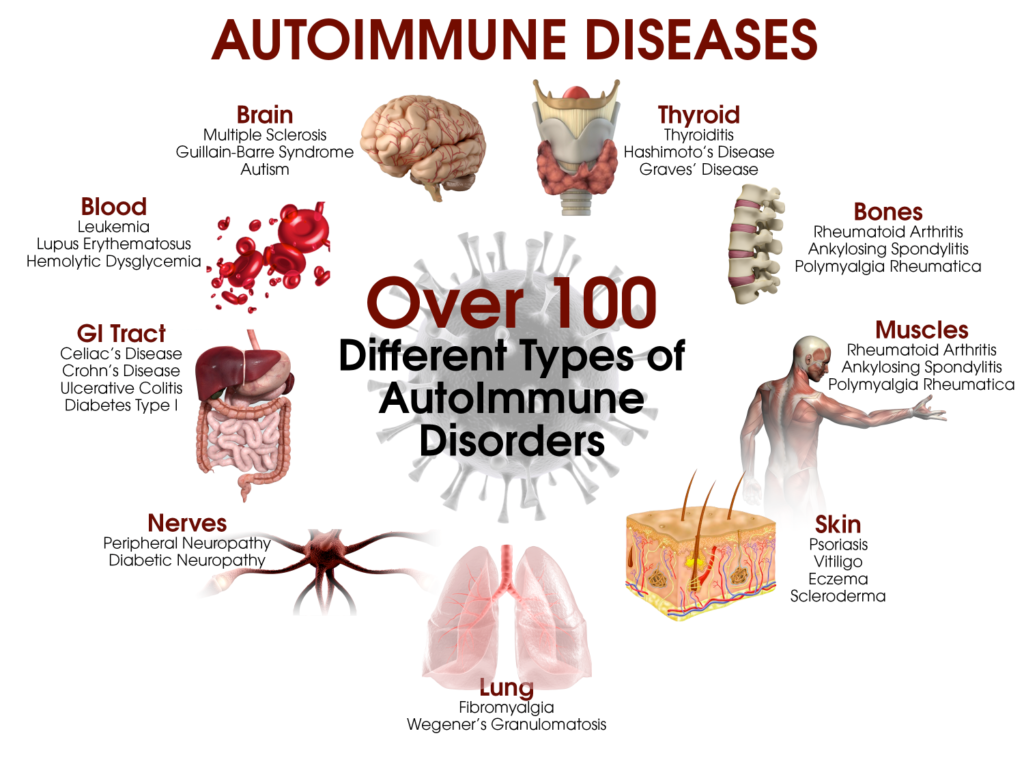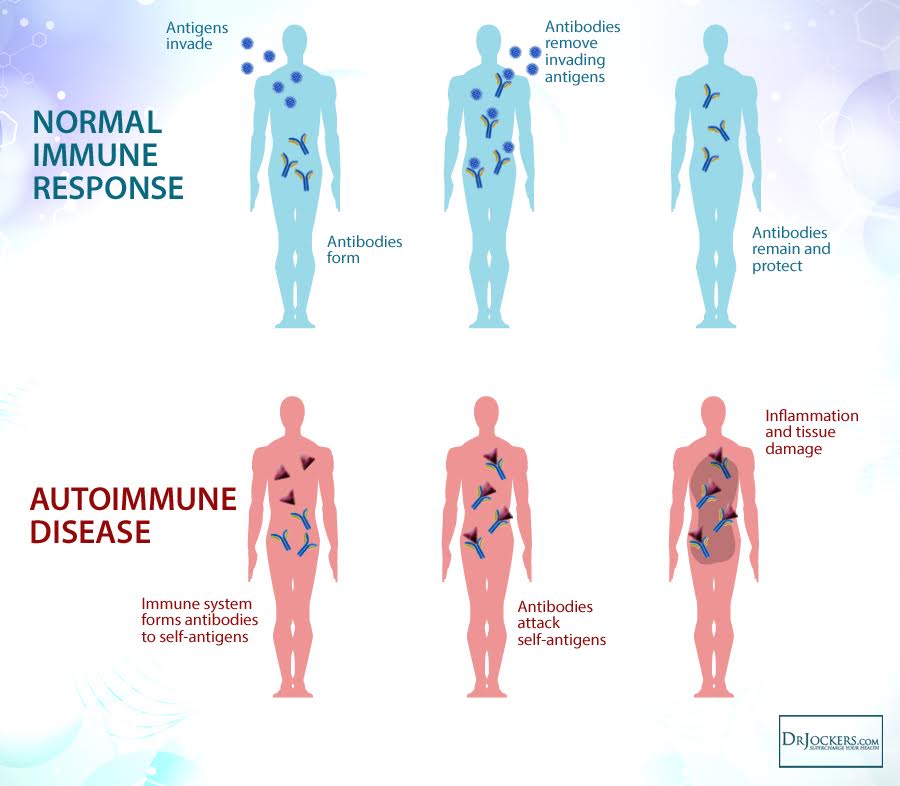The U.S. medical research agency, The National Institutes of Health, sums up autoimmunity:
“When an intruder invades your body—like a cold, virus, or bacteria on a thorn that pricks your skin—your immune system protects you. It tries to identify, kill and eliminate the invaders that might hurt you. But sometimes, problems with your immune system cause it to mistake your body’s own healthy cells as invaders and then repeatedly attacks them. This is called an autoimmune disease. “Autoimmune” means immunity against the self.” (1, NIH).

Dr. Mark Hyman, world renowned functional medicine practitioner, describes autoimmune diseases as “the most common chronic disease…a huge problem in this country [the United States].” He notes that as of 2015:
“As a whole, autoimmune diseases affect over 80 million Americans and five percent of the population in Western countries,” in fact, Hyman says, “More people have autoimmune disease than cancer, heart disease, and diabetes combined,” (2, Hyman).
While the American Autoimmune Related Diseases Association, Inc. states that “50 million Americans suffer from autoimmune disease,” (3, AARDA) – where they state that the numbers depend upon which diseased are included in their count – no experts disagree that the numbers are high, and on the rise. And the issue is not just confined to Western countries. In Australia, for example:
“Autoimmune diseases affect 5% of Australians and are more common than cancer or heart disease. There are over 100 different autoimmune diseases that affect Australians and lead to significant disability. (4, ASCIA)
How autoimmunity presents
So, what are autoimmune diseases? According to Hyman:
“…Autoimmune disease isn’t just one condition. You’re probably familiar with the most common autoimmune diseases, like rheumatoid arthritis, lupus, multiple sclerosis, inflammatory bowel disease, type-1 diabetes, hypothyroidism, and psoriasis. But there are many more autoimmune diseases that affect the nervous system, joints and muscles, skin, endocrine gland, and heart. Simply put, autoimmune diseases are conditions where the body’s immune system attacks its own tissues rather than a foreign molecule like bacteria. This happens when something confuses the immune system.” (5, Hyman)
The U.S. National Institutes of Health identifies 27 diseases that fall into the autoimmune category includes (1, NIH). The American Autoimmune Related Diseases Association, Inc. (AARDA), however, says that whereas “the NIH numbers only include 24 diseases [actually, 27] for which good epidemiology studies were available, researchers have identified 80-100 different autoimmune diseases and suspect at least 40 additional diseases of having an autoimmune basis.” The AARDA list is much more comprehensive than NIH (6, AARDA).
Most experts worldwide do agree that there are more like 80-100 autoimmune conditions:
“Autoimmune diseases are a broad range of related diseases in which a person’s immune system produces an inappropriate response against its own cells, tissues and/or organs, resulting in inflammation and damage. There are over 80 different autoimmune diseases, and these range from common to very rare diseases. Some autoimmune diseases affect mainly one part of the body (such as multiple sclerosis, autoimmune thyroid disease, type 1 diabetes) whilst others can affect many parts of the body (such as systemic lupus erythematosus, rheumatoid arthritis and systemic vasculitis).” (7, ASCIA).
Graphic by Dr. Jockers (8, Jockers)
The immune response

So, what is it? What’s happening in the immune system?
A few basics about the immune system
Here are a few basic operators in the function of our immune system – what they are, and what they’re supposed to do:
- Antigen: a substance that provokes an immune response in the body, usually foreign particles and/or protein.
- Bone marrow: where immune cells are produced.
- Lymphocytes: white blood cells produced in the bone marrow to help eliminate invaders. They become two main types: T-cells and B-cells:
- T-cells: the warriors of the immune system – the good guys — mature in the thymus and directly attack antigens. Each T-cell is taught to recognize one of millions of antigens – the bad guys – and then migrate into the lymphatic system and circulate in the blood so they can do their job.
- B-cells: secrete antibodies, which are proteins produced to hijack antigens as part of an immune response, although they can’t directly attack an antigen the way that a T-cell can.
- Thymus: where some immune cells go to mature and become T-cells, the thymus is a gland in the upper chest in front of the heart.
- Lymphatic system: where other immune cells go to mature and become B-cells in tissue like lymph nodes and the spleen. The lymphatic system also includes lymph fluid, lymphatic vessels, bone marrow, and tonsils, and is essential for the elimination of toxins from tissue.
T-cells and B-cells are meant to recognize the difference between invading “non-self” cells, or antigens, and our own “self” cells by the shape of specific foreign antigen molecules. The immune system is meant to attack only substances and infections that are thought of as foreign invaders or non-self cells. Sometimes, however, the immune system gets confused by what is and what isn’t self and attacks healthy body cells, causing inflammation and tissue damage. That’s an autoimmune response, where “auto” refers to the attack of “self.”
A simple overview of what’s meant to be happening vs. what is, in a patient with autoimmune disorder (8, Jockers).
For more information
My favorite discussion tutorial about what is autoimmunity and a deeper dive into the analysis of it is by Dr. Sarah Ballantyne, popularly known as The Paleo Mom, whose writing delves into the science in a way that laypeople can understand. She has a great deal of information online, which largely delves into the Autoimmune Protocol and the Paleo way of eating. But her book, The Paleo Approach, provides a great deal of insight into the illness if you’re questioning why or whether a certain aspect of a driver is what it is, for example, or would just like more information without having to launch your own scientific inquiry.


